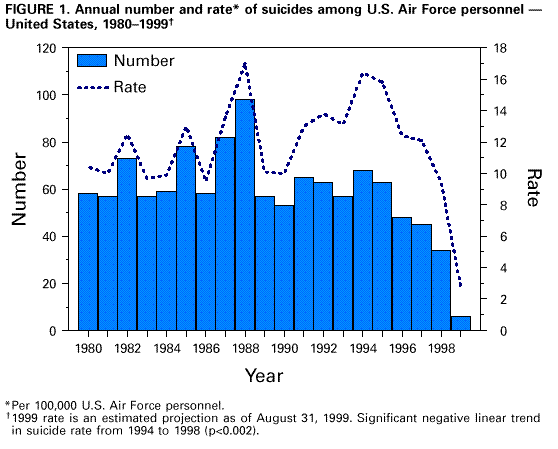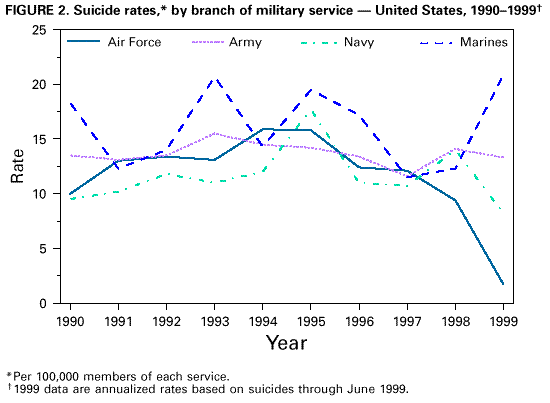 |
|
|
|
|
|
|
| ||||||||||
|
|
|
|
|
|
|
||||
| ||||||||||
|
|
|
|
|
Persons using assistive technology might not be able to fully access information in this file. For assistance, please send e-mail to: mmwrq@cdc.gov. Type 508 Accommodation and the title of the report in the subject line of e-mail. Suicide Prevention Among Active Duty Air Force Personnel -- United States, 1990-1999During 1990-1994, suicide accounted for 23% of all deaths among active duty U.S. Air Force (USAF) personnel and was the second leading cause of death (after unintentional injuries) (Table 1). During those years, the annual suicide rate among active duty USAF personnel increased significantly (p less than 0.01) from 10.0 to 16.4 suicides per 100,000 members (Figure 1). In 1995, senior USAF leaders initiated prevention programs in several commands because of the increasing suicide rate. In May 1996, an in-depth study by a team of medical and nonmedical civilian and military experts was initiated to produce a comprehensive, communitywide prevention strategy that viewed suicide not only as a medical but a USAF problem, thus addressing overall social, behavior, and health issues (1). The plan was implemented across the entire USAF during 1996-1997. This report describes protective and prevention strategies and summarizes the study findings, which indicate that a substantial decline in the suicide rate was associated with the communitywide program. The team's suicide prevention strategy encompassed nearly all the USAF community (e.g., investigative agencies, military justice, and prevention and treatment services) and focused on reducing suicide by emphasizing early interventions, and strengthening protective factors (e.g., a sense of belonging and caring, effective coping skills, and policies that promote help-seeking behavior). These goals correspond to recommendations made by the United Nations (UN) and World Health Organization (WHO) to governments and local communities in developing suicide prevention strategies (2). The initiatives were divided into three categories corresponding to areas identified by other prevention programs: adapting CDC recommendations for youth suicide prevention (3) to the USAF adult population, restructuring prevention services offered on USAF installations (4), and establishing a central surveillance database for fatal and nonfatal self-injuries (5). Adapting CDC Recommendations The team established USAF requirements for annual suicide prevention and awareness training, which was provided to approximately 80% of USAF members. Supervisors and leaders within each military unit, medical providers, attorneys, and chaplains received concentrated training as "gatekeepers" whose role was to channel persons at risk to appropriate agencies. In 1996, the USAF began to administer a comprehensive health questionnaire, including items about mental health status, when USAF members enrolled in the military health-care plan; an abbreviated version was subsequently administered annually. Questionnaire data were used to determine when referral to a health-care provider was indicated. The USAF Chiefs of Staff sent servicewide electronic messages, recognizing the courage and sound judgment of persons who confronted difficult issues and sought professional help (e.g., marital, family, legal, financial, mental health, and spiritual counseling). These messages also stated that military leaders must ensure that members facing substantial stress receive the care and support of their military unit (i.e., local community), even when the stress stemmed from violating community norms (i.e., Uniform Code of Military Justice [UCMJ]). The team also established policies that required any USAF agency investigating a member to coordinate with unit leaders to ensure that the leaders carried out their gatekeeping role. Restructuring of Prevention Services Prevention services on all USAF installations were restructured by establishing a limited psychotherapist-patient privilege to protect members charged under the UCMJ. Mental health providers were mandated to initiate community-based primary prevention, and the USAF integrated the services of the six agencies involved in prevention services (mental health, family support centers, child and youth development, health and wellness centers, chaplains, and family advocacy). The six agencies in each geographic community were required to conduct an assessment of the risk for suicide and to develop a coordinated prevention plan with measurable goals. Surveillance Gathering suicide data from the USAF population is facilitated by standardized data systems that track each member. Each active duty member's death is investigated by the USAF Office of Special Investigations, a forensic agency autonomous from the local command authority. Since 1997, USAF suicide data (completions, attempts, and gestures) have been collected in a database that includes demographics, details of the events, use of prevention services before the event, and associated psychological, social, behavior, and economic factors. From 1994 to 1998, the suicide rate among USAF members decreased significantly, from 16.4 suicides per 100,000 members to 9.4 (p less than 0.002) (Figure 1). On the basis of the first eight months of 1999, the 1999 estimated rate is 2.2 suicides per 100,000 members--approximately 80% lower than the lowest annual rate since 1980 (Figure 1).* Reported by: DA Litts, K Moe, CH Roadman, R Janke, J Miller, Suicide Integrated Product Team, United States Air Force, Dept of Defense. Div of Violence Prevention, National Center for Injury Prevention and Control, CDC. Editorial Note:During 1994-1995, suicide prevention became a USAF priority. Initially, the focus of prevention activities occurred within several major commands; however, this approach was succeeded in 1996 by a servicewide program, whose goals correspond to recommendations made by the UN and WHO to governments and local communities in developing suicide prevention strategies (2). These efforts were temporally associated with a substantial decrease in the suicide rates among active USAF personnel. Suicide rates in the other military services do not demonstrate the sustained decline over the same period (U.S. Army, U.S. Navy, and U.S. Marines, unpublished data, 1999) (Figure 2). The USAF's approach to suicide prevention emphasized the role of the entire community, not only health care, in reducing and preventing factors thought to contribute to suicide. It also included components that promoted protective factors such as social networks. Readiness to address the suicide problem was established quickly because the leaders involved were easily identified and had substantial influence over the community. A program of education and awareness training for all personnel, combined with integrated prevention services in every community, set out to modify the culture of the USAF community. Initiatives are ongoing, established by official policy requiring annual reporting of performance objectives. Evaluation of the program's effectiveness and its generalizability to other groups is subject to at least two limitations. First, although the decline in the suicide rate among USAF personnel corresponds temporally with the interventions, a causal relation between the decline and the program has not been established conclusively nor have components that might have been responsible for the decline been identified. Second, differences exist in the characteristics of active USAF personnel and the U.S. civilian population. All members of the USAF community have completed secondary school, are employed and housed, and have comprehensive health-care benefits, including unlimited mental health care. Since 1974, members have been screened for mental illness before entry. Use of illicit drugs, a risk factor for suicide, is approximately 90% less frequent than in the civilian population after adjusting for age and sex (6). All members have a commander or a first sergeant whose job is to be interested in each member's health and well being. This study highlights that suicide is a preventable health problem and demonstrates the importance of using multiple agencies to address the issue. It also indicates that a communitywide, multiple-strategy program can be planned and implemented and can contribute to reducing self-directed violence. The USAF has assigned a team to monitor the ongoing intervention and surveillance activities and to recommend modifications as needed. The USAF suicide prevention strategy should be tested in other occupation-related communities, such as law enforcement or investigative agencies, to determine whether the programs can be effective in other populations. References
* The 1999 rate was estimated by dividing the number of deaths by the number of months of data to get a monthly average and then multiplied by 12 to get an approximate numerator for the annual rate. Table 1 Note: To print large tables and graphs users may have to change their printer settings to landscape and use a small font size. TABLE 1. Causes of death among active duty U.S. Air Force personnel -- United States, 1990-1994
Return to top. Figure 1  Return to top. Figure 2  Return to top. Disclaimer All MMWR HTML versions of articles are electronic conversions from ASCII text into HTML. This conversion may have resulted in character translation or format errors in the HTML version. Users should not rely on this HTML document, but are referred to the electronic PDF version and/or the original MMWR paper copy for the official text, figures, and tables. An original paper copy of this issue can be obtained from the Superintendent of Documents, U.S. Government Printing Office (GPO), Washington, DC 20402-9371; telephone: (202) 512-1800. Contact GPO for current prices. **Questions or messages regarding errors in formatting should be addressed to mmwrq@cdc.gov.Page converted: 11/24/1999 |
|||||||||||||||||||||||
This page last reviewed 5/2/01
|